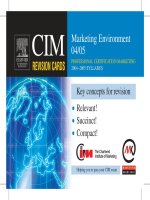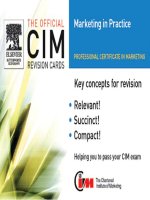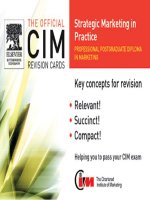CIM revision cards marketing fundamentals by maggie jones of marketing knowledge
Bạn đang xem bản rút gọn của tài liệu. Xem và tải ngay bản đầy đủ của tài liệu tại đây (1.03 MB, 118 trang )
CIM REVISION CARDS
Marketing Fundamentals
Maggie Jones of Marketing Knowledge
AMSTERDAM l BOSTON
PARIS l SAN DIEGO l
HEIDELBERG
SAN FRANCISCO
l
l
l
LONDON l
SINGAPORE
l
NEW YORK
SYDNEY
l
l
OXFORD
TOKYO
Butterworth-Heinemann is an imprint of Elsevier
Linacre House, Jordan Hill, Oxford OX2 8DP
30 Corporate Drive, Suite 400, Burlington, MA 01803
First published 2006
Copyright ß 2006, Elsevier Ltd. All rights reserved
No part of this publication may be reproduced in any material form (including photocopying or storing in any medium by electronic means and whether or not transiently or incidentally to some
other use of this publication) without the written permission of the copyright holder except in accordance with the provisions of the Copyright, Designs and Patents Act 1988 or under the terms of a
licence issued by the Copyright Licensing Agency Ltd, 90 Tottenham Court Road, London, England W1T 4LP. Applications for the copyright holders written permission to reproduce any part of this
publication should be addressed to the publisher
Permissions may be sought directly from Elsevier’s Science & Technology Rights Department in Oxford, UK: phone: (+44) (0) 1865 843830; fax: (+44) (0) 1865 853333,
e-mail: permissions @ elsevier.co.uk. You may also complete your request on-line via the Elseiver homepage
(), by selecting ‘Customer Support’ and then ‘Obtaining Permissions’
British Library Cataloguing in Publication Data
A catalogue record for this book is available from the British Library
Library of Congress Cataloguing in Publication Data
A catalogue record for this book is available from the Library of Congress
ISBN-13: 978-0-7506-6772-2
ISBN-10: 0-7506-6772-9
For information on all Elsevier Butterworth-Heinemann publications visit our website at
Printed and bound in Great Britain
05 06 07 08 09 10
10 9 8 7 6 5 4 3 2 1
Working together to grow
libraries in developing countries
www.elsevier.com | www.bookaid.com | www.sabre.com
TABLE OF CONTENTS
1.
2.
3.
4.
5.
6.
7.
8.
9.
Preface ............................................................................ iv
The development of marketing and marketing orientation .................. 1
Marketing planning and budgeting ............................................. 15
Product ............................................................................ 33
New product development and portfolio management ....................... 47
Price operations .................................................................. 57
Place operations .................................................................. 70
Promotional operations .......................................................... 82
Services and customer care .................................................... 96
Marketing in context ............................................................. 104
PREFACE
Welcome to the CIM Revision Cards from Elsevier/Butterworth–Heinemann. We hope you will find these useful to
revise for your CIM exam. The cards are designed to be used in conjunction with the CIM Coursebooks from
Elsevier/Butterworth–Heinemann, and have been written specifically with revision in mind. They also serve as
invaluable reviews of the complete modules, perfect for those studying via the assignment route.
n Learning outcomes at the start of each chapter identify the main points
n Key topics are summarized, helping you commit the information to memory quickly and easily
n Examination and revision tips are provided to give extra guidance when preparing for the exam
n Key diagrams are featured to aid the learning process
n The compact size ensures the cards are easily transportable, so you can revise any time, anywhere
To get the most of your revision cards, try to look over them as frequently as you can when taking your CIM
course. When read alongside the Coursebook they serve as the ideal companion to the main text. Good luck
– we wish you every success with your CIM qualification!
THE DEVELOPMENT OF
MARKETING AND MARKETING
ORIENTATION
Unit 1
LEARNING OUTCOMES
å Understanding the development of marketing
as an exchange process and a business
philosophy
å Recognizing the contribution of marketing to
create customer value and compete effectively
å Appreciate the importance of marketing
orientation and identify the factors that promote
and impede its adoption
å Understand the role of marketing in
coordinating organizational resources
å Understand the impact of marketing actions
upon society and the need to act in a socially
responsible manner
å Appreciate the significance of the buyer–seller
relationship and the role of relationship
marketing in retaining customers
Syllabus Reference: 1.1–1.6
MARKETING FUNDAMENTALS
1
THE DEVELOPMENT OF MARKETING AND MARKETING ORIENTATION
KEY REVISION POINTS
å The importance of a marketing orientated
culture to the effective implementation of
marketing strategies within the organization
å Understanding the dynamics of the buyer–
seller relationship across a range of industry
sectors
å Understanding the role of ICT in further
development of marketing orientation
å The importance of internal marketing in
building and sustaining a marketing culture
within the organization
2
What is Marketing?
The management process which identifies, anticipates and satisfies customer requirements
efficiently and profitably
n Central focus is the customer
n Aim is to satisfy their needs
Marketing is about creating a mutually beneficial
exchange (Dibb et al.) determined by
n Encompasses selling, researching markets
and attracting and retaining customers
n Two parties must participate
n Requires a set of management activities to be
in place to enable organization to compete
n Both parties must be willing to exchange
n Each party must possess something of value
n Usually involves exchanging money for goods
and services
The Marketing Concept puts the customer at the centre of all business decision-making. An organization
with this approach is said to be marketing orientated to have a marketing culture.
MARKETING FUNDAMENTALS
3
THE DEVELOPMENT OF MARKETING AND MARKETING ORIENTATION
4
The Development of Marketing
Orientation
1900–1930 Production Orientation – focused on what
the organization can produce, not if there is a need for
what can be produced
Factors underpinning further development
n Customers are better educated and
knowledgeable, exercising more power
n Higher disposable income available
n Overcapacity of goods and services
1930–1960 Selling Orientation – focused on
persuading customers to buy through using selling and
promotion
n Emergence of global brands via better travelled
customers and increased information
1960–present day Marketing Orientation – identifies
what the customer wants and attempts to satisfy
those needs better than the competition and within the
organizational capabilities
n Increased channels to market
n Better quality information enables closer
segmentation and targeting
Marketing Culture – the first step to developing a
marketing culture within an organization is to ensure
all employees at all levels and functions have the
ability and information to ‘think customers’
MARKETING FUNDAMENTALS
5
THE DEVELOPMENT OF MARKETING AND MARKETING ORIENTATION
Creating a Sustainable Competitive
Advantage
Organizational Factors Required
for Marketing Culture to Flourish
Marketing orientation can enable the organization
to compete by
n Committed senior management
n Creating and maintaining superior value through
effective application of the marketing mix
n Customer satisfaction inherent in all job
description
n Creating a link between customer needs and
organizational strengths
n Training in customer care for all
n Consider the competition from the customer
perspective
6
n Specific board level marketing responsibility
n Training in marketing developments for marketing
staff
n Reward and motivation systems in place
n Regular marketing research
Internal Marketing to Create a
Marketing Culture
Key Definition – The creation of an internal
environment which supports customer consciousness
and sales-mindedness amongst all personnel within
an organization
Benefits
n More profitable organizations
n Increasing need for jobs and staff development
n Greater job satisfaction possible
n Better skilled, empowered employees
Internal marketing must demonstrate
n The organizational objectives and strategies within
the markets they compete in
n The importance to the organization of delivering
superior customer value
n The rewards available through implementing
successful strategies
n How all employees contribute to the customer
experience
n An understanding of the differing needs and
requirements of differing employee groups
n How improving customer care improves job
satisfaction and motivation
MARKETING FUNDAMENTALS
7
THE DEVELOPMENT OF MARKETING AND MARKETING ORIENTATION
Barriers to Implementing
a Marketing Culture
n Failure of managers to understand and embrace
a marketing culture
n Resistance to change
n Political power struggles between the
organization’s functions and departments
n Lack of clearly defined responsibility for internal
marketing
n Organizational structure may inhibit two-way
communication and dissemination of information
8
Marketing must Play a Coordinating role
Wider application of Marketing Culture
Not-for-Profit
The marketing environment is dynamic and ever
changing
These organizations exist for reasons other than to
produce profit and are often service based, e.g.
hospitals, universities, and charities. Usually have to
operate within a tight regulatory framework and the
‘customers’ are numerous and have very different and
often conflicting needs.
Marketing has spread from the FMCG sectors and
is now prevalent in many other industry sectors
Business-to-Business (B2B)
Purchasing on behalf of the organization rather than
for personal use. Key relationships between supplier,
manufacturers and distributors to deliver added value
to the end user. Buying decision-making process
(DMP) longer and involves more people (DMU)
Service Industries
Dominate in many developed economies such as USA
and UK. Key issues are Intangibility, Inseparability and
Perishability. Benefits much more difficult to
communicate.
Global Marketing
The emergence of a global village. Customers around
the world have similar lifestyles and consumption
patterns to their global neighbours. Increased mobility
and education of consumers, aligned with more
efficient communication, has led to the growth of
global brands
MARKETING FUNDAMENTALS
9
THE DEVELOPMENT OF MARKETING AND MARKETING ORIENTATION
10
Further Developments
Societal Marketing
Relationship Marketing
Aims to maximize the value generated from the
exchange for buyer and seller by establishing a
longer-term relationship and brand loyal customers.
Database technology has enabled tracking of
purchases and targeted communication. Focus on
increasing Customer Lifetime Value – CLV
Organizations have become more environmentally
aware in response to customers becoming more
discerning. The possible effect of marketing activities
and provision of goods and services on society and the
environment are also key differentiators in the minds
of more and more customers. More organizations
developing a stance on Corporate Social Responsibility
(CSR)
Quality and Customer Care
Database Marketing
Arises from the need to build relationships. Marketing
has recognized that customers perceive quality and
level of customer care delivered as a differentiating
factor when purchasing. More powerful consumers
now expect and demand consistent quality and service
Increased information availability and channels of
communication via ICT developments have led to
better segmentation, shorter time to market and
increased channels to market. Flexibility has led to
greater differentiation in product/service offering
Marketing as a Management Function
Key Tasks of the Marketing Manager
Key steps in marketing planning
Analysis – Assessment of
Micro Factors – Customers, competition,
supply chain, other stakeholders
Macro factors – Legal, Social, Economic,
Technological, Political, Environmental
Planning – Process detailed on the left
Implementation – Ensuring budgets and resources
are in place to implement the plan and the plans are
communicated and accepted
Control – Measuring the effectiveness of the plan
implemented in relation to achievement of objectives
set. Changed circumstances may lead to plans being
amended. Process continues on to the next planning
cycle
MARKETING FUNDAMENTALS
11
THE DEVELOPMENT OF MARKETING AND MARKETING ORIENTATION
Marketing Mix – Tools of Marketing Management
Key Definition – The marketing mix is the set of controllable variables which the marketer uses to
develop marketing plans and programmes
Basic 4Ps – As developed by Neil Borden
The Extended/Service Mix – 7 Ps
Product
Process
Price
People
Place
Physical Evidence
Promotion
12
Growth of Technology in Marketing
Helps with the development of a marketing-orientated
culture by
Major Effects on the Marketing Environment include
n Using sophisticated databases to understand
Customer Behavior
n Greater price competition as customers can
compare prices via the Internet – price
transparency
n Using the Internet to gather competitor information
n Building customer care systems
n Identifying segments and niches with differing
needs
n Gathering information to underpin effective
marketing planning and decision-making
n Growth of home shopping
n Potential demise of some markets to be replaced
by new products and industries
n New relationships and level of interaction between
members of the value chain
MARKETING FUNDAMENTALS
13
THE DEVELOPMENT OF MARKETING AND MARKETING ORIENTATION
14
Hints and Tips
n Read through Unit 1 of the Marketing
Fundamentals Coursebook – these revision tips
relate closely to it
n Challenge theories where you think they may not
be appropriate or where you think they could be
disproven
n The Marketing Fundamentals exam is about being
able to apply a range of concepts and theories in
the context of an organization
n Use examples to support your answers where
appropriate – e.g. Egg, easyJet, Starbucks. . .
n Answer the question asked!
n You need to show the examiner that you can
understand how to ‘do marketing’!
n Break down the different components of the
questions to ensure you address all of the issues
n Introduce different theories to underpin your
answers
n Have a go at as many past exam questions as
possible
n Use as many process models as possible to help
you remember key concepts
n Go to www.cimvirtualinstitute.com and
www.marketingonline.co.uk for additional support
and guidance
MARKETING PLANNING AND
BUDGETING
Unit 2
LEARNING OUTCOMES
KEY REVISION POINTS
å Understanding the importance of the planning
process and the structure and stages of the
marketing plan
å Understanding the models available in the audit
and strategy formulation stages of the marketing
plan
å Understanding the importance of objective
setting, market segmentation and the value of
marketing research to the planning process
å Appreciate the range of tools and techniques
available to satisfy customer needs and compete
effectively
å Understand the process of setting marketing
budgets
å The relationship between the marketing plan and
the corporate plan
å What is marketing strategy and the basics of a
good marketing strategy?
å The role and components of the marketing plan
and barriers to marketing planning
Syllabus Reference: 2.1 through to 2.11, 3.1, 3.16
MARKETING FUNDAMENTALS
15
MARKETING PLANNING AND BUDGETING
Why Plan?
More organizations now undertake a structured
planning process because:
n The marketing environment is highly competitive
and change is occurring at a rapid rate
n High levels of investment are required to develop
new products and services
n More sophisticated planning techniques and tools
are available
n Marketing personnel are better trained and have
access to better quality data and information
n Organizations recognize the need to integrate all
functions of the organization to better meet the
customers needs
The advantages are:
n A structured analysis of the environment the
organization operates within is undertaken
n Objectives and strategies are based on the
strengths and resources available
n Proactive approach rather than a reactive one
enables the organization to compete better
n Increased customer focus possible
n Better use of organizational resources
16
The Planning Process
See Unit 1 for the extended process, but more simply
M.A.O.S.T.I.C.
How do we get there?
MARKETING FUNDAMENTALS
17
MARKETING PLANNING AND BUDGETING
Marketing in the context of the organization
Marketing plays a role in feeding information upwards to provide guidance, direction and vision for the
corporate objectives and the development of the corporate strategy, as shown in the Strategy and
Planning Hierarchy below.
n Corporate planning starts at the top of the
organization and impinges upon every aspect and
every division or department of the organization
n Corporate strategy and plans are clearly linked
to achieving the mission and vision of the
organization
n Each business unit has responsibility for the
development of its own function plans
18
MARKETING FUNDAMENTALS
19
MARKETING PLANNING AND BUDGETING
Understanding the stages in more detail
Mission – What business are we in? What are our
values?
Objectives – Need to be SMART. Focus on growth,
financial performance, reputation and corporate social
responsibility (CSR)
Audit – Should encompass all aspects of the
organization and the environment it operates within.
Assessment of skills, resources and systems the
organization have used to develop a SCA. See SWOT
Internal/micro-Competitors
Distributors
External/macro-Legal
Economic
Social
Customers
Suppliers
Political
Technological
Environmental
20
Objectives – provide the guiding framework on how
the company will compete in a market place. Should
relate to:
Market share
Market scope – range of products/services
Innovation – NPD
Positioning
Market position
Strategy – see below
Implementation – detailing the actions required
to bring the Marketing Plan to life. Include:
Men
Materials
Money
Minutes
Machines
Control – Measurement vs. objectives









